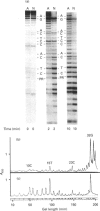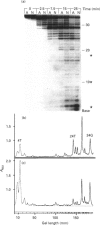Abstract
2-Chloro-2'-deoxyadenosine triphosphate, a purine nucleotide analogue and potent antileukaemic agent, was incorporated into double-stranded 36-mers in place of dATP to investigate the effects of 2-chloroadenine (ClAde) on DNA polymerase-associated 3'-->5' exonuclease activity. ClAde residues within one strand of duplex DNA did not inhibit exonuclease activity; on the contrary, ClAde-containing minus strands were digested to a greater extent than was control DNA in the absence of deoxyribonucleoside triphosphates by Escherichia coli Klenow fragment, yeast DNA polymerase II and T4 DNA polymerase. After a 30 min incubation with 5 units of Klenow fragment, approximately 65% of control DNA remained in DNA fragments of 26 bases or larger compared with only approximately 25% of ClAde-substituted substrates. Unsubstituted plus strands opposite a ClAde-containing strand were likewise digested more quickly by 3'-->5' exonuclease, but only in the vicinity of the ClAde sites. Approx. 63% of the plus strands from ClAde-containing oligomers were less than 24 bases in length after a 25 min digestion period with Klenow fragment compared with only approximately 32% of control DNA. Such results indicate that, unlike other base modifications such as pyrimidine dimers, methoxy psoralen adducts and certain nucleoside analogues, all of which inhibit or decrease the rate of strand degradation by 3'-->5' exonucleases, incorporated ClAde enhances strand degradation of duplex DNA.
Full text
PDF




Images in this article
Selected References
These references are in PubMed. This may not be the complete list of references from this article.
- Araki H., Ropp P. A., Johnson A. L., Johnston L. H., Morrison A., Sugino A. DNA polymerase II, the probable homolog of mammalian DNA polymerase epsilon, replicates chromosomal DNA in the yeast Saccharomyces cerevisiae. EMBO J. 1992 Feb;11(2):733–740. doi: 10.1002/j.1460-2075.1992.tb05106.x. [DOI] [PMC free article] [PubMed] [Google Scholar]
- Avery T. L., Rehg J. E., Lumm W. C., Harwood F. C., Santana V. M., Blakley R. L. Biochemical pharmacology of 2-chlorodeoxyadenosine in malignant human hematopoietic cell lines and therapeutic effects of 2-bromodeoxyadenosine in drug combinations in mice. Cancer Res. 1989 Sep 15;49(18):4972–4978. [PubMed] [Google Scholar]
- Beese L. S., Derbyshire V., Steitz T. A. Structure of DNA polymerase I Klenow fragment bound to duplex DNA. Science. 1993 Apr 16;260(5106):352–355. doi: 10.1126/science.8469987. [DOI] [PubMed] [Google Scholar]
- Beutler E. Cladribine (2-chlorodeoxyadenosine) Lancet. 1992 Oct 17;340(8825):952–956. doi: 10.1016/0140-6736(92)92826-2. [DOI] [PubMed] [Google Scholar]
- Bichara M., Fuchs R. P. DNA binding and mutation spectra of the carcinogen N-2-aminofluorene in Escherichia coli. A correlation between the conformation of the premutagenic lesion and the mutation specificity. J Mol Biol. 1985 Jun 5;183(3):341–351. doi: 10.1016/0022-2836(85)90005-1. [DOI] [PubMed] [Google Scholar]
- Carson D. A., Wasson D. B., Kaye J., Ullman B., Martin D. W., Jr, Robins R. K., Montgomery J. A. Deoxycytidine kinase-mediated toxicity of deoxyadenosine analogs toward malignant human lymphoblasts in vitro and toward murine L1210 leukemia in vivo. Proc Natl Acad Sci U S A. 1980 Nov;77(11):6865–6869. doi: 10.1073/pnas.77.11.6865. [DOI] [PMC free article] [PubMed] [Google Scholar]
- Carson D. A., Wasson D. B., Taetle R., Yu A. Specific toxicity of 2-chlorodeoxyadenosine toward resting and proliferating human lymphocytes. Blood. 1983 Oct;62(4):737–743. [PubMed] [Google Scholar]
- Chase J. W., Richardson C. C. Exonuclease VII of Escherichia coli. Purification and properties. J Biol Chem. 1974 Jul 25;249(14):4545–4552. [PubMed] [Google Scholar]
- Chunduru S. K., Appleman J. R., Blakley R. L. Activity of human DNA polymerases alpha and beta with 2-chloro-2'-deoxyadenosine 5'-triphosphate as a substrate and quantitative effects of incorporation on chain extension. Arch Biochem Biophys. 1993 Apr;302(1):19–30. doi: 10.1006/abbi.1993.1175. [DOI] [PubMed] [Google Scholar]
- Doetsch P. W., Chan G. L., Haseltine W. A. T4 DNA polymerase (3'-5') exonuclease, an enzyme for the detection and quantitation of stable DNA lesions: the ultraviolet light example. Nucleic Acids Res. 1985 May 10;13(9):3285–3304. doi: 10.1093/nar/13.9.3285. [DOI] [PMC free article] [PubMed] [Google Scholar]
- Estey E. H., Kurzrock R., Kantarjian H. M., O'Brien S. M., McCredie K. B., Beran M., Koller C., Keating M. J., Hirsch-Ginsberg C., Huh Y. O. Treatment of hairy cell leukemia with 2-chlorodeoxyadenosine (2-CdA). Blood. 1992 Feb 15;79(4):882–887. [PubMed] [Google Scholar]
- Griffig J., Koob R., Blakley R. L. Mechanisms of inhibition of DNA synthesis by 2-chlorodeoxyadenosine in human lymphoblastic cells. Cancer Res. 1989 Dec 15;49(24 Pt 1):6923–6928. [PubMed] [Google Scholar]
- Gupta G., Sarma M. H., Sarma R. H. On the question of DNA bending: two-dimensional NMR studies on d(GTTTTAAAAC)2 in solution. Biochemistry. 1988 Oct 4;27(20):7909–7919. doi: 10.1021/bi00420a049. [DOI] [PubMed] [Google Scholar]
- Hentosh P., Grippo P. Template 2-chloro-2'-deoxyadenosine monophosphate inhibits in vitro DNA synthesis. Mol Pharmacol. 1994 May;45(5):955–961. [PubMed] [Google Scholar]
- Hentosh P., Koob R., Blakley R. L. Incorporation of 2-halogeno-2'-deoxyadenosine 5-triphosphates into DNA during replication by human polymerases alpha and beta. J Biol Chem. 1990 Mar 5;265(7):4033–4040. [PubMed] [Google Scholar]
- Hentosh P., McCastlain J. C., Blakley R. L. Effects of 2-chloro-2'-deoxyadenosine 5'-triphosphate on DNA synthesis in vitro by purified bacterial and viral DNA polymerases. Biochemistry. 1991 Jan 15;30(2):547–554. doi: 10.1021/bi00216a032. [DOI] [PubMed] [Google Scholar]
- Hentosh P., McCastlain J. C. Effects of 2-chloroadenine substitution in DNA on restriction endonuclease cleavage reactions. Nucleic Acids Res. 1991 Jun 11;19(11):3143–3148. doi: 10.1093/nar/19.11.3143. [DOI] [PMC free article] [PubMed] [Google Scholar]
- Hirota Y., Yoshioka A., Tanaka S., Watanabe K., Otani T., Minowada J., Matsuda A., Ueda T., Wataya Y. Imbalance of deoxyribonucleoside triphosphates, DNA double-strand breaks, and cell death caused by 2-chlorodeoxyadenosine in mouse FM3A cells. Cancer Res. 1989 Feb 15;49(4):915–919. [PubMed] [Google Scholar]
- Huang M. C., Ashmun R. A., Avery T. L., Kuehl M., Blakley R. L. Effects of cytotoxicity of 2-chloro-2'-deoxyadenosine and 2-bromo-2'-deoxyadenosine on cell growth, clonogenicity, DNA synthesis, and cell cycle kinetics. Cancer Res. 1986 May;46(5):2362–2368. [PubMed] [Google Scholar]
- Huang M. C., Hatfield K., Roetker A. W., Montgomery J. A., Blakley R. L. Analogs of 2'-deoxyadenosine: facile enzymatic preparation and growth inhibitory effects on human cell lines. Biochem Pharmacol. 1981 Oct 1;30(19):2663–2671. doi: 10.1016/0006-2952(81)90535-9. [DOI] [PubMed] [Google Scholar]
- Huang P., Chubb S., Hertel L. W., Grindey G. B., Plunkett W. Action of 2',2'-difluorodeoxycytidine on DNA synthesis. Cancer Res. 1991 Nov 15;51(22):6110–6117. [PubMed] [Google Scholar]
- Huang P., Farquhar D., Plunkett W. Selective action of 2',3'-didehydro-2',3'-dideoxythymidine triphosphate on human immunodeficiency virus reverse transcriptase and human DNA polymerases. J Biol Chem. 1992 Feb 5;267(4):2817–2822. [PubMed] [Google Scholar]
- Kay A. C., Saven A., Carrera C. J., Carson D. A., Thurston D., Beutler E., Piro L. D. 2-Chlorodeoxyadenosine treatment of low-grade lymphomas. J Clin Oncol. 1992 Mar;10(3):371–377. doi: 10.1200/JCO.1992.10.3.371. [DOI] [PubMed] [Google Scholar]
- Kuchta R. D., Benkovic P., Benkovic S. J. Kinetic mechanism whereby DNA polymerase I (Klenow) replicates DNA with high fidelity. Biochemistry. 1988 Sep 6;27(18):6716–6725. doi: 10.1021/bi00418a012. [DOI] [PubMed] [Google Scholar]
- Marini J. C., Levene S. D., Crothers D. M., Englund P. T. Bent helical structure in kinetoplast DNA. Proc Natl Acad Sci U S A. 1982 Dec;79(24):7664–7668. doi: 10.1073/pnas.79.24.7664. [DOI] [PMC free article] [PubMed] [Google Scholar]
- Montgomery J. A. Has the well gone dry? The First Cain Memorial Award Lecture. Cancer Res. 1982 Oct;42(10):3911–3917. [PubMed] [Google Scholar]
- Nickel W., Austermann S., Bialek G., Grosse F. Interactions of azidothymidine triphosphate with the cellular DNA polymerases alpha, delta, and epsilon and with DNA primase. J Biol Chem. 1992 Jan 15;267(2):848–854. [PubMed] [Google Scholar]
- Panigrahi G. B., Walker I. G. The N2-guanine adduct but not the C8-guanine or N6-adenine adducts formed by 4-nitroquinoline 1-oxide blocks the 3'-5' exonuclease action of T4 DNA polymerase. Biochemistry. 1990 Feb 27;29(8):2122–2126. doi: 10.1021/bi00460a023. [DOI] [PubMed] [Google Scholar]
- Parker W. B., Bapat A. R., Shen J. X., Townsend A. J., Cheng Y. C. Interaction of 2-halogenated dATP analogs (F, Cl, and Br) with human DNA polymerases, DNA primase, and ribonucleotide reductase. Mol Pharmacol. 1988 Oct;34(4):485–491. [PubMed] [Google Scholar]
- Piro L. D., Carrera C. J., Beutler E., Carson D. A. 2-Chlorodeoxyadenosine: an effective new agent for the treatment of chronic lymphocytic leukemia. Blood. 1988 Sep;72(3):1069–1073. [PubMed] [Google Scholar]
- Piro L. D., Carrera C. J., Carson D. A., Beutler E. Lasting remissions in hairy-cell leukemia induced by a single infusion of 2-chlorodeoxyadenosine. N Engl J Med. 1990 Apr 19;322(16):1117–1121. doi: 10.1056/NEJM199004193221605. [DOI] [PubMed] [Google Scholar]
- Sage E., Moustacchi E. Sequence context effects on 8-methoxypsoralen photobinding to defined DNA fragments. Biochemistry. 1987 Jun 16;26(12):3307–3314. doi: 10.1021/bi00386a010. [DOI] [PubMed] [Google Scholar]
- Santana V. M., Mirro J., Jr, Harwood F. C., Cherrie J., Schell M., Kalwinsky D., Blakley R. L. A phase I clinical trial of 2-chlorodeoxyadenosine in pediatric patients with acute leukemia. J Clin Oncol. 1991 Mar;9(3):416–422. doi: 10.1200/JCO.1991.9.3.416. [DOI] [PubMed] [Google Scholar]
- Santana V. M., Mirro J., Jr, Kearns C., Schell M. J., Crom W., Blakley R. L. 2-Chlorodeoxyadenosine produces a high rate of complete hematologic remission in relapsed acute myeloid leukemia. J Clin Oncol. 1992 Mar;10(3):364–370. doi: 10.1200/JCO.1992.10.3.364. [DOI] [PubMed] [Google Scholar]
- Saven A., Carrera C. J., Carson D. A., Beutler E., Piro L. D. 2-Chlorodeoxyadenosine: an active agent in the treatment of cutaneous T-cell lymphoma. Blood. 1992 Aug 1;80(3):587–592. [PubMed] [Google Scholar]
- Tallman M. S., Hakimian D., Variakojis D., Koslow D., Sisney G. A., Rademaker A. W., Rose E., Kaul K. A single cycle of 2-chlorodeoxyadenosine results in complete remission in the majority of patients with hairy cell leukemia. Blood. 1992 Nov 1;80(9):2203–2209. [PubMed] [Google Scholar]
- Voigt J. M., Topal M. D. O6-methylguanine and A.C and G.T mismatches cause asymmetric structural defects in DNA that are affected by DNA sequence. Biochemistry. 1990 May 29;29(21):5012–5018. doi: 10.1021/bi00473a003. [DOI] [PubMed] [Google Scholar]





